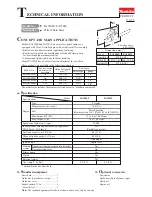
14
For Your Safety
❏
Support large panels to minimise the risk of
blade pinching and kickback.
Large panels
tend to sag under their own weight. Supports
must be placed under the panel on both sides,
near the line of cut and near the edge of the
panel.
❏
Do not use dull or damaged blades.
Unsharp-
ened or improperly set blades produce narrow
kerf causing excessive friction, blade binding
and kickback.
❏
Blade depth and bevel adjusting locking le-
vers must be tight and secure before making
cut.
If blade adjustment shifts while cutting, it
may cause binding and kickback.
❏
Use extra caution when making a “plunge
cut” into existing walls or other blind areas.
The protruding blade may cut objects that can
cause kickback.
❏
Check lower guard for proper closing before
each use. Do not operate the saw if lower
guard does not move freely and close instant-
ly. Never clamp or tie the lower guard into the
open position.
If saw is accidentally dropped,
lower guard may be bent. Raise the lower
guard with the retracting handle and make sure
it moves freely and does not touch the blade or
any other part, in all angles and depths of cut.
❏
Check the operation of the lower guard
spring. If the guard and the spring are not op-
erating properly, they must be serviced before
use.
Lower guard may operate sluggishly due
to damaged parts, gummy deposits, or a build-
up of debris.
❏
Lower guard should be retracted manually
only for special cuts such as “plunge cuts” and
“compound cuts”. Raise lower guard by re-
tracting handle and as soon as blade enters
the material, the lower guard must be re-
leased.
For all other sawing, the lower guard
should operate automatically.
❏
Always observe that the lower guard is cover-
ing the blade before placing saw down on
bench or floor.
An unprotected, coasting blade
will cause the saw to walk backwards, cutting
whatever is in its path. Be aware of the time it
takes for the blade to stop after switch is re-
leased.
❏
Do not work overhead with the saw.
this man-
ner you do not have sufficient control over the
power tool.
❏
Use appropriate detectors to determine if util-
ity lines are hidden in the work area or call the
local utility company for assistance.
Contact
with electric lines can lead to fire and electric
shock. Damaging a gas line can lead to explo-
sion. Penetrating a water line causes property
damage or may cause an electric shock.
❏
Do not operate the power tool stationary.
It is
not designed for operation with a saw table.
❏
Do not use high speed steel (HSS) saw blades.
Such saw blades can easily break.
❏
Do not use grinding discs.
Grinding discs are
not permitted for use with this power tool.
❏
When working with the machine, always hold
it firmly with both hands and provide for a se-
cure stance.
The power tool is guided more se-
cure with both hands.
❏
Secure the workpiece.
workpiece clamped with
clamping devices or in a vice is held more se-
cure than by hand.
❏
Always wait until the machine has come to a
complete stop before placing it down.
The tool
insert can jam and lead to loss of control over
the power tool.
❏
Avoid unintentional switching on. Ensure the
On/Off switch is in the off position before in-
serting battery pack.
Carrying the power tool
with your finger on the On/Off switch or insert-
ing the battery pack into power tools that have
the switch on invites accidents.
❏
Before each use, check the machine and bat-
tery. If damage is detected, do not use the ma-
chine.
Have repairs performed only by a qual-
ified technician. Never open the machine your-
self.
❏
Before any work on the power tool (e. g.
maintenance, changing the tool, etc.), remove
the battery.
There is danger of injury from an
accidentally starting power tool.
❏
Use power tools only with specifically desig-
nated battery packs.
Use of any other battery
packs may create a risk of injury and fire.
❏
Never allow children to use the machine.
❏
Use only original Würth parts and accesso-
ries.
HKS 28 A - Buch Seite 14 Montag, 10. Dezember 2007 3:20 15















































